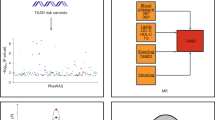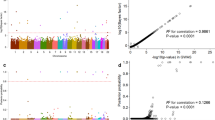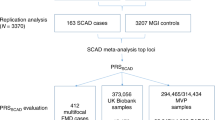Abstract
We performed a genome-wide association study on 1,292 individuals with abdominal aortic aneurysms (AAAs) and 30,503 controls from Iceland and The Netherlands, with a follow-up of top markers in up to 3,267 individuals with AAAs and 7,451 controls. The A allele of rs7025486 on 9q33 was found to associate with AAA, with an odds ratio (OR) of 1.21 and P = 4.6 × 10−10. In tests for association with other vascular diseases, we found that rs7025486[A] is associated with early onset myocardial infarction (OR = 1.18, P = 3.1 × 10−5), peripheral arterial disease (OR = 1.14, P = 3.9 × 10−5) and pulmonary embolism (OR = 1.20, P = 0.00030), but not with intracranial aneurysm or ischemic stroke. No association was observed between rs7025486[A] and common risk factors for arterial and venous diseases—that is, smoking, lipid levels, obesity, type 2 diabetes and hypertension. Rs7025486 is located within DAB2IP, which encodes an inhibitor of cell growth and survival.
This is a preview of subscription content, access via your institution
Access options
Subscribe to this journal
Receive 12 print issues and online access
$209.00 per year
only $17.42 per issue
Buy this article
- Purchase on Springer Link
- Instant access to full article PDF
Prices may be subject to local taxes which are calculated during checkout

Similar content being viewed by others
Accession codes
References
Crawford, C.M., Hurtgen-Grace, K., Talarico, E. & Marley, J. Abdominal aortic aneurysm: an illustrated narrative review. J. Manipulative Physiol. Ther. 26, 184–195 (2003).
Weintraub, N.L. Understanding abdominal aortic aneurysm. N. Engl. J. Med. 361, 1114–1116 (2009).
Annambhotla, S. et al. Recent advances in molecular mechanisms of abdominal aortic aneurysm formation. World J. Surg. 32, 976–986 (2008).
Grootenboer, N., Bosch, J.L., Hendriks, J.M. & van Sambeek, M.R. Epidemiology, aetiology, risk of rupture and treatment of abdominal aortic aneurysms: does sex matter? Eur. J. Vasc. Endovasc. Surg. 38, 278–284 (2009).
Assar, A.N. & Zarins, C.K. Ruptured abdominal aortic aneurysm: a surgical emergency with many clinical presentations. Postgrad. Med. J. 85, 268–273 (2009).
Wahlgren, C.M., Larsson, E., Magnusson, P.K., Hultgren, R. & Swedenborg, J. Genetic and environmental contributions to abdominal aortic aneurysm development in a twin population. J. Vasc. Surg. 51, 3–7 discussion 7 (2010).
Ogata, T. et al. The lifetime prevalence of abdominal aortic aneurysms among siblings of aneurysm patients is eightfold higher than among siblings of spouses: an analysis of 187 aneurysm families in Nova Scotia, Canada. J. Vasc. Surg. 42, 891–897 (2005).
Sandford, R.M., Bown, M.J., London, N.J. & Sayers, R.D. The genetic basis of abdominal aortic aneurysms: a review. Eur. J. Vasc. Endovasc. Surg. 33, 381–390 (2007).
Shibamura, H. et al. Genome scan for familial abdominal aortic aneurysm using sex and family history as covariates suggests genetic heterogeneity and identifies linkage to chromosome 19q13. Circulation 109, 2103–2108 (2004).
Van Vlijmen-Van Keulen, C.J., Rauwerda, J.A. & Pals, G. Genome-wide linkage in three Dutch families maps a locus for abdominal aortic aneurysms to chromosome 19q13.3. Eur. J. Vasc. Endovasc. Surg. 30, 29–35 (2005).
Helgadottir, A. et al. The same sequence variant on 9p21 associates with myocardial infarction, abdominal aortic aneurysm and intracranial aneurysm. Nat. Genet. 40, 217–224 (2008).
Thompson, A.R. et al. Sequence variant on 9p21 is associated with the presence of abdominal aortic aneurysm disease but does not have an impact on aneurysmal expansion. Eur. J. Hum. Genet. 17, 391–394 (2009).
Bown, M.J. et al. Association between the coronary artery disease risk locus on chromosome 9p21.3 and abdominal aortic aneurysm. Circ. Cardiovasc. Genet. 1, 39–42 (2008).
Elmore, J.R. et al. Identification of a genetic variant associated with abdominal aortic aneurysms on chromosome 3p12.3 by genome wide association. J. Vasc. Surg. 49, 1525–1531 (2009).
Mantel, N. & Haenszel, W. Statistical aspects of the analysis of data from retrospective studies of disease. J. Natl. Cancer Inst. 22, 719–748 (1959).
Evans, D.M., Frazer, I.H. & Martin, N.G. Genetic and environmental causes of variation in basal levels of blood cells. Twin Res. 2, 250–257 (1999).
Iwashita, S. & Song, S.Y. RasGAPs: a crucial regulator of extracellular stimuli for homeostasis of cellular functions. Mol. Biosyst. 4, 213–222 (2008).
Xie, D. et al. DAB2IP coordinates both PI3K-Akt and ASK1 pathways for cell survival and apoptosis. Proc. Natl. Acad. Sci. USA 106, 19878–19883 (2009).
Chen, H., Pong, R.C., Wang, Z. & Hsieh, J.T. Differential regulation of the human gene DAB2IP in normal and malignant prostatic epithelia: cloning and characterization. Genomics 79, 573–581 (2002).
Qiu, G.H. et al. Differential expression of hDAB2IPA and hDAB2IPB in normal tissues and promoter methylation of hDAB2IPA in hepatocellular carcinoma. J. Hepatol. 46, 655–663 (2007).
Dimmeler, S. et al. Activation of nitric oxide synthase in endothelial cells by Akt-dependent phosphorylation. Nature 399, 601–605 (1999).
Shiojima, I. & Walsh, K. Role of Akt signaling in vascular homeostasis and angiogenesis. Circ. Res. 90, 1243–1250 (2002).
Yoshimura, K. et al. Regression of abdominal aortic aneurysm by inhibition of c-Jun N-terminal kinase. Nat. Med. 11, 1330–1338 (2005).
Zhang, H. et al. AIP1 functions as an endogenous inhibitor of VEGFR2-mediated signaling and inflammatory angiogenesis in mice. J. Clin. Invest. 118, 3904–3916 (2008).
Helgadottir, A. et al. A common variant on chromosome 9p21 affects the risk of myocardial infarction. Science 316, 1491–1493 (2007).
McPherson, R. et al. A common allele on chromosome 9 associated with coronary heart disease. Science 316, 1488–1491 (2007).
Prandoni, P. Links between arterial and venous disease. J. Intern. Med. 262, 341–350 (2007).
Sørensen, H.T., Horvath-Puho, E., Pedersen, L., Baron, J.A. & Prandoni, P. Venous thromboembolism and subsequent hospitalisation due to acute arterial cardiovascular events: a 20-year cohort study. Lancet 370, 1773–1779 (2007).
Braekkan, S.K. et al. Family history of myocardial infarction is an independent risk factor for venous thromboembolism: the Tromso study. J. Thromb. Haemost. 6, 1851–1857 (2008).
Sabeti, P.C. et al. Genome-wide detection and characterization of positive selection in human populations. Nature 449, 913–918 (2007).
Gretarsdottir, S. et al. The gene encoding phosphodiesterase 4D confers risk of ischemic stroke. Nat. Genet. 35, 131–138 (2003).
Rice, J.A. Generalized likelihood ratio tests. in Mathematical Statistics and Data Analysis Vol 1 (ed. Rice, J.A.) 308–310 (International Thomson Publishing, 1995).
Rafnar, T. et al. Sequence variants at the TERT-CLPTM1L locus associate with many cancer types. Nat. Genet. 41, 221–227 (2009).
Devlin, B. & Roeder, K. Genomic control for association studies. Biometrics 55, 997–1004 (1999).
Marchini, J., Howie, B., Myers, S., McVean, G. & Donnelly, P. A new multipoint method for genome-wide association studies by imputation of genotypes. Nat. Genet. 39, 906–913 (2007).
Frazer, K.A. et al. A second generation human haplotype map of over 3.1 million SNPs. Nature 449, 851–861 (2007).
Cordell, H.J. Epistasis: what it means, what it doesn't mean, and statistical methods to detect it in humans. Hum. Mol. Genet. 11, 2463–2468 (2002).
Acknowledgements
We thank the individuals who participated in the study and whose contribution made this work possible. This study was funded in part through grants from the US National Heart, Lung, and Blood Institute (NHLBI), National Institutes of Health (R01HL089650-02), and from two projects in the European Community′s Seventh Framework Programme (FP7/2007-2013): the Fighting Aneurysmal Disease project grant agreement HEALTH-F2-2008-200647, and ENGAGE project grant agreement HEALTH-F4-2007-201413. The gene expression study in aorta and mammary artery was funded by the Swedish Research Council (12660) and a donation by F. Lundberg. The recruitment of AAA sample sets and controls from Belgium, Canada and Pittsburgh was funded in part by grants from the NHLBI (HL064310 to H.K. and HL044682 to R.E.F.). The Finnish IA sample collection was funded in part by the US National Institute of Neurological Disorders and Stroke (NS034395 to G. Tromp), the American Heart Association, Michigan Affiliate (to G. Tromp) and the University of Kuopio (to A.R.). A.F.B. and Y.M.R. were supported by grants from the Dr. E. Dekker program of the Netherlands Heart Foundation (2009T001 and 2005T014 respectively). New Zealand samples were recruited and genotyped through the Vascular Research Consortium of New Zealand with funding via a program grant from the Health Research Council of New Zealand. Sample collection in Danville, Pennsylvania, was funded by a grant from the American Heart Association (to D.J.C.). UK sample collection was funded partially by grants from the UK Medical Research Council and the British Heart Foundation (to J.T.P.). The recruitment of VTE patients and controls from Spain was funded in part by grants from the Instituto Carlos III (RECAVA RD06/0014/0004, RD06/0014/0039 and 06/0014/0016). DNA isolation of Dutch AAA samples was funded from a grant from the Novartis Foundation for Cardiovascular Excellence. The GeneSTAR Research Program was funded in part by the NHLBI (HL087698 to L.C.B. and HL58625 to D.M.B.). The Danish Study of control subjects was funded by research grants from the Danish Research Council, the Danish Diabetes Association, the Danish Centre for Health Technology Assessment, Novo Nordisk, the Research Foundation of Copenhagen County, the Danish Ministry of Internal Affairs and Health, the Danish Heart Foundation, the Danish Pharmaceutical Association, the Augustinus Foundation, the Ib Henriksen Foundation, the Becket Foundation and the Velux foundation. The Inter99 was initiated by T.J. (principal investigator), K. Borch-Johnsen (co-principal investigator), H. Ibsen and T.F. Thomsen. The steering committee comprises the former two and C. Pisinger.
Author information
Authors and Affiliations
Contributions
The study was designed and results interpreted by S.G., A.F.B., H.H., G. Thorleifsson, U.T. and K.S. The first draft was written by S.G., A.F.B., H.H., G. Thorleifsson and U.T. Statistical analysis was performed by G. Thorleifsson, A.K., P.S., G. Masson and G.B.W. Expression analysis was designed and implemented by Adalbjorg Jonasdottir and Aslaug Jonasdottir. Biological material collection and handling was supervised by J.S., S.G., K.P.M. and U.T. Genotyping was supervised by S.G., M.M., J.P.K. and U.T. Collection of vessel wall biopsies and gene expression analyses in aorta and mammary artery were performed by L.F., A.F.-C. and P.E. Those responsible for patient and control ascertainment, recruitment and phenotypic information were S.E.M. and S.G. (AAA and PAD Iceland); A.F.B., M.d.H., J.-P.P.M.d.V., S.E.K., C.J.A.M.Z., S.M.v.S., R.H.G., D.E.G. and J.D.B. (AAA Utrecht, The Netherlands); G.T.J. and A.M.v.R., (AAA, PAD and controls, New Zealand); A.P.M.B. (AAA and controls, Nijmegen, The Netherlands); S.U. and J.S.L. (AAA and PAD, Denmark); N.S., R.L., J.-O.D. and H.K. (AAA and controls, Belgium); H.K. (AAA and controls, Canada); H.K. and R.E.F. (AAA, Pittsburgh); J.R.E. and D.J.C. (AAA, PAD and controls, Danville, Pennsylvania); J.T.P. (AAA, UK); T.M., B.D. and M.H. (PAD and controls, Austria); E.G. and R. Pola (PAD and controls, Italy); B.L. and A.G. (PAD and controls, Sweden); K.A. and G. Thorgeirsson (MI, Iceland); L.C.B. and D.M.B. (MI and controls, Baltimore); G.T.J. and M.J.A.W. (MI, New Zealand); S.H.S. and C.B.G. (MI, Durham, North Carolina); V. Vaccarino, R.S.P., A.M.Z. and A.A.Q. (MI, Atlanta); E.T., G. Malerba, N.M., O.O., P.F.P. and D.G. (MI and controls, Italy); M.P.R. and D.J.R. (MI, Philadelphia); I.O., M.K.M., R. Palmason, V.H. and P.T.O. (VTE, Iceland); N.L., M.F., M.R. and P.W. (VTE and controls, Canada); F.E., J.F., V. Vicente and J.C. (VTE and controls, Spain); S.G., S.S. and E.M.V. (stroke, Iceland); S.G., H.B.M. and E.M.V. (IA, Iceland); G. Tromp and A.R. (IA and controls, Finland); C.W. and Y.M.R. (IA, The Netherlands); G.B.W. and G. Thorleifsson (obesity, Iceland); V.S. (type 2 diabetes, Iceland); H.H. (hypertension, Iceland); G. Thorleifsson and H.S. (smoking, Iceland); T.R., K.K.A., J.d.G., S.H. and L.A.K. (controls, Nijmegen, The Netherlands); V.S., T.H., D.R.W., T.J., N.G. and O.P. (controls, Denmark); H.A. and A.I.L. (controls, Atlanta); and H.S. and D.A.C. (controls, UK). All authors contributed to the final version of the paper.
Corresponding authors
Ethics declarations
Competing interests
Authors whose affiliations are listed as deCODE Genetics are employees of deCODE Genetics, a biotechnology company. deCODE Genetics intends to incorporate the variants described in this paper into its genetic testing services.
Supplementary information
Supplementary Text and Figures
Supplementary Note, Supplementary Figures 1 and 2 and Supplementary Tables 1–7 (PDF 2712 kb)
Rights and permissions
About this article
Cite this article
Gretarsdottir, S., Baas, A., Thorleifsson, G. et al. Genome-wide association study identifies a sequence variant within the DAB2IP gene conferring susceptibility to abdominal aortic aneurysm. Nat Genet 42, 692–697 (2010). https://doi.org/10.1038/ng.622
Received:
Accepted:
Published:
Issue Date:
DOI: https://doi.org/10.1038/ng.622
This article is cited by
-
The Genetics of Inheritable Aortic Diseases
Current Cardiovascular Risk Reports (2022)
-
Polygenic Susceptibility of Aortic Aneurysms Associates to the Diameter of the Aneurysm Sac: the Aneurysm-Express Biobank Cohort
Scientific Reports (2019)
-
SMYD2 promoter DNA methylation is associated with abdominal aortic aneurysm (AAA) and SMYD2 expression in vascular smooth muscle cells
Clinical Epigenetics (2018)
-
Association of the single nucleotide polymorphism in chromosome 9p21 and chromosome 9q33 with coronary artery disease in Chinese population
BMC Cardiovascular Disorders (2017)
-
Monocytes and macrophages in abdominal aortic aneurysm
Nature Reviews Cardiology (2017)



